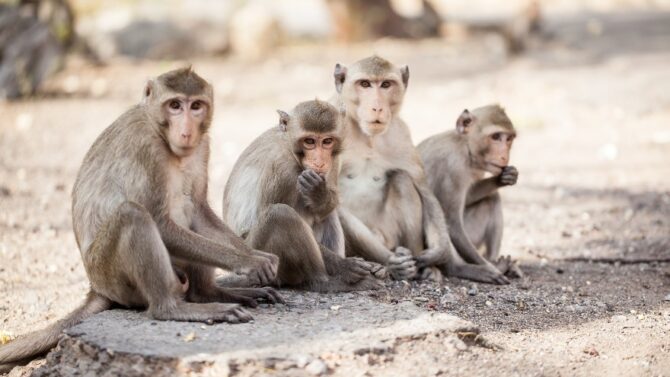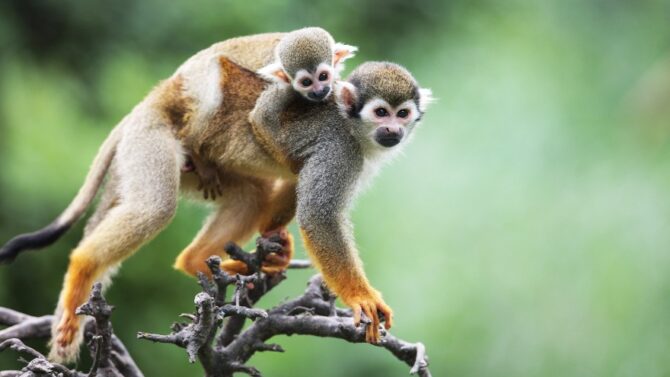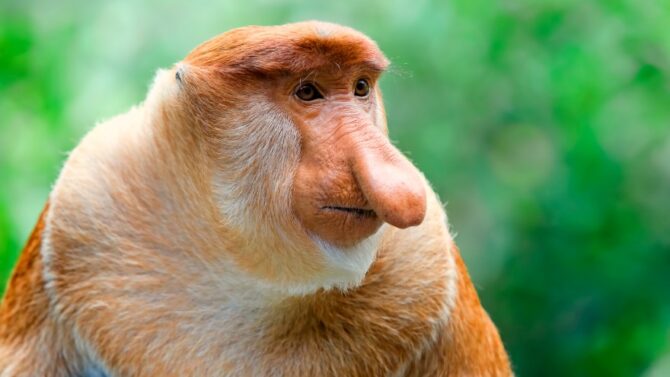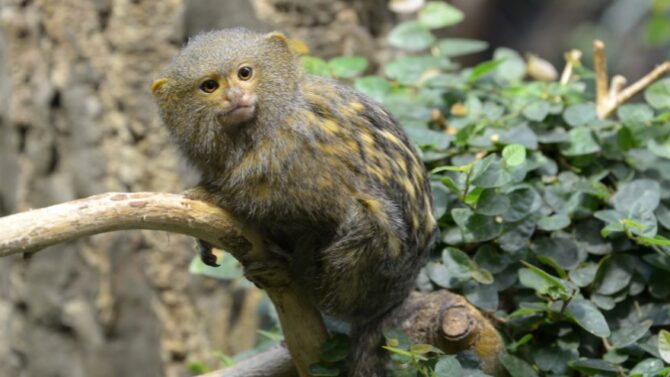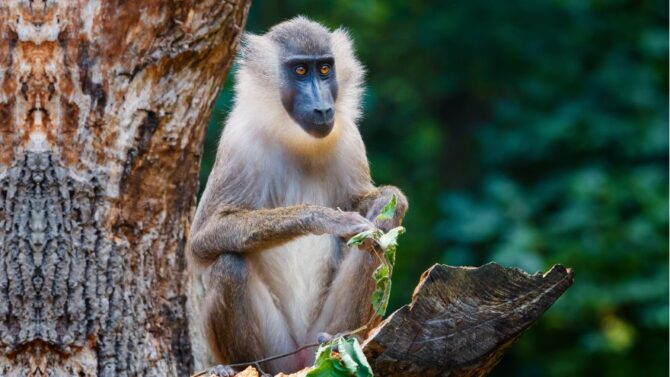The playful nature and intelligence of monkeys is well established. Over two hundred known species are grouped under New World and Old World Monkeys and can be found all over the world.
Although every one of these monkeys has distinctive traits, they also differ in size, color, and shape.
This article will explore the different types of monkeys, including popular species like the macaque, mona monkey, mandrill, tiny pygmy marmoset, and massive mandrill, among many others.
Read on to discover the species names, identification tips, and fun facts, along with pictures so that you can get a better idea of what each monkey looks like.
Without further ado, let us dive right in!
The Different Types of Monkeys
1. Mona Monkey
- Scientific Name: Cercopithecus mona
- Identifying features: Brown agouti fur; white rump; black legs and tail; blue-grey face with stripes across
- Where Found: Nigeria, Ghana, Cameroon, Senegal, Congo, Angola
- Conservation Status: Near Threatened
From the guenon group of African monkeys, typically located between Ghana and Cameroon, the mona monkey is an old-word monkey species.1
These monkeys are very social, with a group of five and fifty monkeys. Mona monkeys are usually active in the early hours of the morning or late in the afternoon and inhabit forests and rainforests.
Still, one can find them on and about in Afi Mountain Wildlife Sanctuary, Okomu, Cross River, and Gashaka-Gumti national parks in Nigeria, Fazio-Malfakassa National Park in Togo, Tafi Atome Monkey Sanctuary in Ghana, and Mount Cameroon National Park in Cameroon, among others, where they primarily feed on fruits and seeds.
2. Olive Baboon
- Scientific Name: Papio anubis
- Identifying Features: Olive-coloured coat; long square, muzzle with large protruding nostrils; spotted with long hair draped from head to shoulders in males
- Where Found: Ethiopia, Tanzania, Mali, Chad
- Conservation Status: Least Concern
Large, bulkily built, and endowed with powerful limbs — the olive baboon.
This old-world monkey is one of the most widely dispersed monkeys, with an olive-colored coat and thick manes covering the males’ shoulders and heads.
baboons are adept at climbing and are very social, forming groups of tens to hundreds in savannahs, grasslands, deserts, and rainforests.
Therefore, olive baboons exist in Nairobi National Park in Kenya, Kainji Lake National Park in Nigeria, and Arusha National Park in Tanzania.
3. Barbary Macaque
- Scientific Name: Macaca Sylvanus
- Identifying Features: Thick, brown-yellow fur; no visible tail; the presence of cheek pouches
- Where Found: Morocco, Algeria, Libya, Tunisia, Gibraltar
- Conservation Status: Endangered
The Barbary macaque is a tailless monkey, also known as the Barbary ape, that inhabits the pine woods of the Atlas and Rif Mountains between the Moroccan and Algerian border.
It once roamed many areas in Europe and North Africa but is now the sole primate species found in the northern Sahara desert region.
Macaques are most active in the day, with males and females taking care of their young in mixed-gender communities.
Various plants, fruits, seeds, fungi, insects, lizards, and agricultural products make up their diversified diet.
One can find the Barbary macaque in the Ifrane National Park in Morocco.
4. Rhesus Macaque
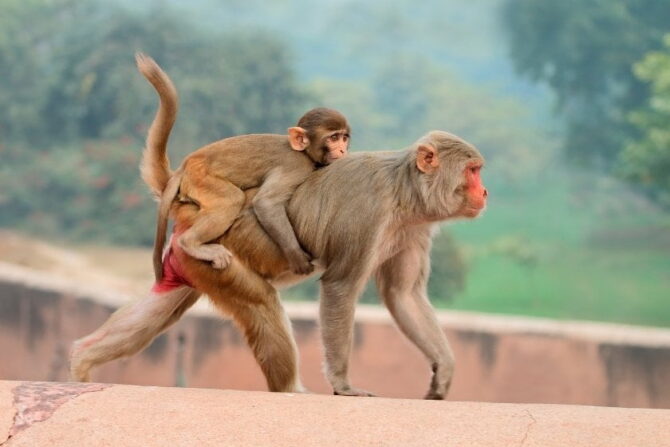
- Scientific Name: Macaca mulatta
- Identifying Features: Red face and rear; medium-length tail
- Where Found: Afghanistan, Pakistan, India, China, Southeast Asia
- Conservation Status: Least Concern
Perhaps you know of the first human to go to space, but what about the first primate?
The Rhesus macaque holds that title. Rhesus macaques are dispersed across mainland Asia, and the Bantimurung-Bulusaraung National Park in Indonesia is one of the best places to find the monkey.
Outside Asia, the Silver Springs State Park in Florida, United States, is another beautiful location to watch the Rhesus macaque thrive in its natural habitat.
Rhesus macaques inhabit various locations, including urban areas, dense woodlands, and agricultural areas.
Although they dwell in trees, they are excellent swimmers that spend most of their time on the ground in quest of food. They eat fruit, seeds, roots, and bark.
Interestingly, Rhesus macaques have a long history of interaction with humans and have been helpful in numerous medical and scientific studies.2
5. Japanese Macaque

- Scientific Name: Macaca fuscata
- Identifying Features: Silvery grey to light brown coat; face with no hair; short tail
- Where Found: Japan
- Conservation Status: Least Concern
Except for Hokkaido, all of Japan’s major islands are home to the Japanese macaque, also called the snow monkey.
Sadly such locations are covered in snow for most of the year, forcing these monkeys to take baths in hot springs heated by nearby volcanoes.
On average, Japanese macaques live between 22 and 27 years feeding on fruits, seeds, flowers, snails, crabs, and crayfish. The size of the males doubles that of the females.
The Jigokudani Snow Monkey Park in Japan could be the best location to watch the Japanese macaque.
Still, the Shiga Kogen National Park, Arashiyama Monkey Park, and Mt. Takao Monkey Park, among others, are other places to find Japanese macaques.
6. Crab-eating Macaque
- Scientific Name: Macaca fascicularis
- Identifying Features: Tufts of hair atop the head; grey or dark-brown fur with a lighter shade on the underbelly; long tails
- Where Found: Bangladesh, Singapore, Philippines, Hong Kong, Taiwan, Papua New Guinea
The long-tailed macaque of Southeast Asia inhabits coastal forests, mangroves, riverine areas, and swamps and remarkably adjusts to various environments.
Crab-eating macaques are active during the day and have excellent swimming and tree-climbing skills; their tails are used for balance when they jump between trees.
One can find crab-eating macaques in several places, including Mauritius and Tinjil, Indochina, Myanmar, Malaysia, Sumatra, Borneo, Java, and many more islands.
Mu Ko Lanta Marine National Park in Thailand and Bako National Park in Malaysia are some of the nicest places to find crab-eating macaques.
7. Mandrills

- Scientific Name: Mandrillus sphinx
- Identifying Features: Large and furry head; blue and red nose; red lips; strong limbs
- Where Found: Cameroon, Republic of the Congo, Gabon, Equatorial Guinea
- Conservation Status: Vulnerable
These large monkeys are the most colorful of the old-world monkeys that one could technically call the peacocks of the primate world.
With colors cascading down their face, blue along the nose, and bright red in the middle where their nose is down to their lips, they also have gold beards.
Females have duller colors and are usually half the size of males. Equatorial Guinea’s rainforests, forested savannahs, and dense secondary woods are home to them.
However, the Lopé National Park in Gabon, and Odzala-Kokoua National Park in Congo, offer sights of these colorful monkeys.
8. Vervet Monkey
- Scientific Name: Chlorocebus pygerythrus
- Identifying Features: Black face; white ear tufts
- Where Found: Ethiopia, Somalia, South Sudan, South Africa
- Conservation Status: Least Concern
The vervet is a tiny, black-faced monkey that inhabits many East African habitats.
The abdomen of a male vervet monkey is bluish, one feature that differentiates it from other monkeys.
Further features include a vivid blue scrotum and a red penis. There are five Vervet subspecies, but they measure an average height of over a foot and seven inches, with a black-tipped tail.
The vervet monkey uses all four limbs when climbing trees and moving over the ground. Only rarely does it move from one tree to another.
Velvet monkeys live in the high bush, savanna, and woodland habitats. Adult males establish a dominant structure within the flock.
Sometimes they wander about communities of up to fifty people and are quite social.
Albeit living in these rural communities, one can find the vervet monkey in the Kruger National Park and Madikwe Game Reserve in South Africa, Linyanti-Selinda-Kwando Reserve in Botswana, and Liwondé National Park in Malawi, among others.
9. Blue Monkey
- Scientific Name: Cercopithecus mitis
- Identifying Features: Yellowish patches on the face; bare face, olive-grey coat
- Where Found: Somalia, Angola, Burundi, Ethiopia, Kenya, Malawi, Mozambique, Rwanda, South Africa, DR Congo
- Conservation Status: Least Concern
The blue monkey is light gray, so you would be disappointed if you were looking to see a monkey covered in blue.
The Congo basin and the southern, eastern, and central rain forests of Africa are home to blue monkeys.
This monkey is also called a disarmed monkey because just above its brow line is a fringe of white hairs in the shape of a tiara.
Male blue monkeys are slightly larger than females despite weighing no more than six kilograms.
Blue monkeys inhabit damp, shaded environments, evergreen forests, forest canopies, and bamboo forests.
However, the constant availability of water is essential for a blue monkey’s presence.
The Lake Manyara and Lake Manyara National Parks in Tanzania and Kakamega Forest in Kenya provide the perfect conditions for the blue monkey.
10. Black Snub-nosed Monkey
- Scientific Name: Rhinopithecus bieti
- Identifying Features: White faces with thick pink lips; inwardly curved nostrils; whitish-grey cheeks and underbelly; black fur on the back, arms, and lower legs
- Where Found: China
- Conservation Status: Endangered
The black snub-nosed monkey is endemic to the Yunnan province in southern China.
These monkeys flourish at extreme altitudes despite the subfreezing temperatures and thin air, thanks to their ability to adapt to special environments.
However, they have adaptive features to sustain such a harsh climate, with thick fur to keep them warm in below-freezing temperatures.
Black snub-nosed monkeys spend most of their lives on trees doing business during the day.
They number up to five hundred when food becomes scarce, like during winter.
The Baima Snow Mountain and Tacheng Black Snub-nosed Monkey National Parks in China should be on top of one’s list if one visits the country to find this monkey.
11. Chacma Baboon
- Scientific Name: Papio ursinus
- Identifying Features: Dog-like face; grey fur, black hands and feet; bent tail
- Where Found: Angola, Botswana, Mozambique, Namibia, South Africa, Zambia, Zimbabwe
- Conservation Status: Least Concern
Large portions of southern Africa are home to chacma baboons. They live in various settings, including savanna, grassland steppe, and wooded highlands of Kruger, Marakele, and Table Mountain National Parks and the Thomas Baines Nature Reserve in South Africa.
To decide their roving range, they consider the accessibility of water and sleeping areas.
These monkeys prefer to wander on all fours on the ground and sleep on cliffs and rocks at night instead of climbing trees.
Baboons from the Chacma species wander in groups of twenty to eighty, consuming various plants and animals in their diet. Chacma baboons assist in seed dispersal.
12. Proboscis Monkey
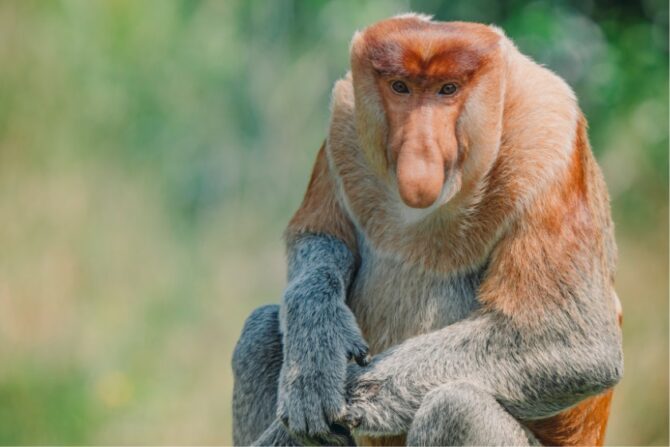
- Scientific Name: Nasalis larvatus
- Identifying Features: Reddish-brown skin color; long nose, swollen stomach; long tail
- Where Found: Indonesia, Malaysia
- Conservation Status: Endangered
Only one island in Southeast Asia, Borneo, is home to the proboscis monkey.
However, one can find the long-nosed monkey in the Kutai National Park in Borneo, Bako National Park in Malaysia, Mount Palung, and Danau Sentarum National Parks in Indonesia.
This monkey favors lowland forests, particularly those near rivers and mangroves, for its habitat. The name “proboscis monkey” points to the animal’s long, fleshy nose, as you might have guessed.
The Proboscis Monkey is a highly gregarious creature that lives in groups of two to thirty people in the nearby mangroves.
Proboscis monkeys are technically omnivores. However, the majority of their diet consists of tough mangrove leaves that they gather from nearby trees.
13. Red Leaf Monkey
- Scientific Name: Presbytis rubicunda
- Identifying Features: Reddish fur; pale lower lips; dark face with wide eyes
- Where Found: Indonesia, Malaysia
- Conservation Status: Least Concern
Red leaf monkeys are primates from the Old World monkeys, also known as maroon leaf monkeys, that inhabit Southeast Asia.
A furry body and tail with a reddish-maroon tint characterize these monkeys.
Therefore, one can find them in Kinabalu Park in Malaysia, Sepilok Forest Reserve, and some forest reserves in the Southeastern Asian country.
They occasionally venture outside of their normal rainforest habitat in quest of food but always occupy trees, being highly terrestrial creatures.
These animals live in groups of twelve to thirteen members, with a dominant male leading them. Young leaves, fruits, seeds, and flowers are part of their diet.
14. Night Monkeys
- Scientific Name: Aotus
- Identifying Features: Large eyes, round flat face, greyish to brownish fur
- Where Found: Panama, Colombia, Ecuador, Peru, Brazil, Paraguay, Argentina, Bolivia, Venezuela
- Conservation Status: Vulnerable
Also known as owl monkeys, this primate resembles owls as the only nocturnal monkeys in the world, rightly giving them their name, Night monkeys.
Aotus, translating to “earless,” suits night monkeys because their concealed ears and wide eyes let them see better at night in the jungle.
Night monkeys occupy tropical rainforests and riverside woodlands in South American countries, where fruit makes up their menu.
They are monogamous and can be seen in families of two to three primates, with the young ones being actively cared for by their fathers.
The Pico da Neblina National Park and Rio Trombetas Biological Reserve in Brazil are among the best places to find a night monkey.
15. Black-handed Spider Monkey
- Scientific Name: Ateles geoffroyi
- Identifying Features: Red, black, or brown, lengthy tail
- Where Found: Mexico, Costa Rica, Panama
- Conservation Status: Endangered
Seven species of spider monkeys are known for their ability to dangle from tree branches and swing through due to their long limbs.
Being arboreal, black-handed spider monkeys prefer to reside in the top canopy of the forests in Central and South America.
They only have four fingers with no thumbs, but they perfectly compensate for their shortage with their tail.
Their tail is very strong, supporting the weight of these primates as they hang onto tree branches. Black-handed spider monkeys often dwell in huge groups of around thirty individuals.
16. Common Marmoset
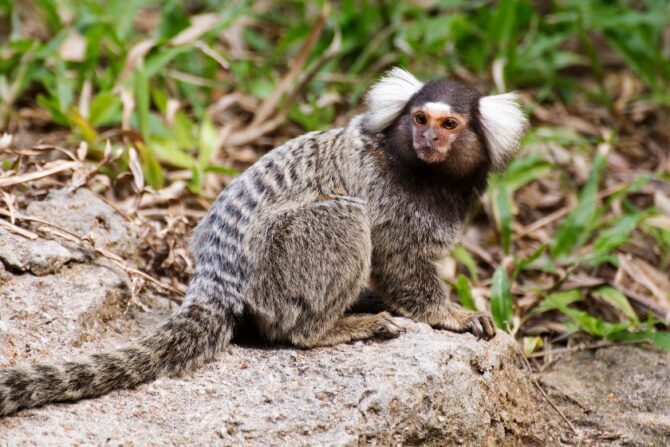
- Scientific Name: Callithrix jacchus
- Identifying Features: white ear tufts; long, banded tails; mottled brown, grey, and yellow color
- Where Found: Brazil
- Conservation Status: Least Concern
The common marmoset is a new world monkey characterized by white-tufted-ear and small size, measuring not up to a foot and weighing less than one kilogram.
This monkey has an arboreal locomotion identical to squirrels, hanging onto trees vertically and leaping between them.
The common marmoset’s appearance is not the only feature that distinguishes it from other monkeys; it enjoys a unique diet, primarily comprised of plant exudates and insects.
The common marmoset is endemic to east-central Brazil. The Tijuca National Park and Sugarloaf Mountain in Rio de Janeiro present the chance to see this monkey in its natural habitat.
17. Golden Snub-Nosed Monkey
- Scientific Name: Rhinopithecus roxellana
- Identifying Features: Dark markings around the crown, nape, outer arms, thighs, and tail; golden-orange foreheads, necks, and stomachs
- Where Found: China
- Conservation Status: Endangered
The golden snub-nosed monkey is another snub-nosed monkey endemic to China.
These beautiful monkeys are covered with long, golden guard hairs on their backs and cape that help them withstand colder temperatures better than other non-human primates.
They inhabit mountainous forests of Central and Southwestern China, frequently seen in the Tacheng Yunnan Snub-nosed Monkey National Park, Baima Snow Mountain National Park, and Shennongjia National Park.
18. Panamanian White-Faced Capuchin
- Scientific Name: Cebus imitator
- Identifying Features: Pink face; white fur around the face and front part of the body
- Where Found: Central America
- Conservation Status: Vulnerable
As the name suggests, the Panamanian white-faced capuchin is a monkey endemic to Central America, especially Panama and Costa Rica.
This new world monkey is popular for its pink face with white fur around its head and body and for its intelligence and crucial role in rainforest ecology, dispersing seeds and pollen.
Panamanian white-faced capuchins inhibit the jungles, including evergreen, deciduous, dry, moist, mangrove, and montane forests, feeding on plant materials and hunting invertebrates and small vertebrates.
The Coiba island national park in the Republic of Panama, Arenal Volcano and Barra Honda National Parks in Costa Rica, Children’s Eternal Rainforest, and Cabo Blanco Absolute Reserve in Costa Rica are great places to find the Panamanian white-faced capuchin.
19. Central American Spider Monkey
- Scientific Name: Ateles Geoffroyi
- Identifying Features: Black feet and hands; light brown, yellowish-beige, red, or whitish lighter undersides; black faces with eyes encircled by white
- Where Found: The Americas
- Conservation Status: Endangered
The Central American spider monkeys are five subspecies of monkeys that occupy the semi-deciduous, mangrove, and rainforests of North, Central, Ecuador, and Colombia in South America.
They are titled one of the largest New World monkeys but are easily identified by their black arms, significantly longer than their legs, and lighter undersides.
While Central American spider monkeys suffer population decline due to habitat loss and capture for the pet trade, one can find them in Palenque National Park and Montes Azules, El Triunfo, and Los Tuxtlas biological reserves in Mexico, Manuel Antonio National Park, Costa Rica, and Tikal National Pico Bonito National Park in Honduras.
20. Pygmy Marmoset
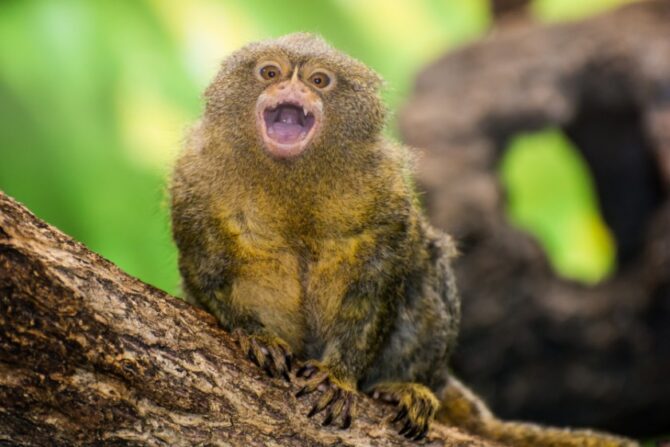
- Scientific Name: Cebuella
- Identifying Features: Fawn, gray coat; yellow, green, and black tick on the head and back
- Where Found: Bolivia, Brazil, Colombia, Ecuador, Peru
- Conservation Status: Least Concern
Pygmy marmosets are two new world monkeys in the genus Cebuella, endemic to South America’s Amazon Basin.
This species is popular for being the world’s smallest monkey, weighing just 0.1 kilograms and measuring between 4.6 and 6 inches.
They inhabit evergreen and river-edge forests and feed tree gums and saps. An expedition to the western Amazon Basin allows one to see these monkeys.
21. Colombian Red Howler
- Scientific Name: Alouatta seniculus
- Identifying Features: Lack of pads on their rumps, red coat
- Where Found: Colombia, Bolivia, Venezuela, Brazil, Ecuador
- Conservation Status: Least Concern
The Colombian red howler earns a reputation as one of the largest of the new world monkeys.
However, the monkey’s bright red coloration makes it easily identifiable. The howler eats leaves primarily, but fruits, flowers, and nuts might complement its diet.
These monkeys have a range that spreads throughout South America’s neotropical rainforests and occurs in the riparian forests of the Eastern Llanos of Colombia.
22. Northern Plains Gray Langur
- Scientific Name: Semnopithecus entellus
- Identifying Features: Black triangular-shaped faces; wide and hazelnut-colored eyes
- Where Found: India, Bangladesh
- Conservation Status: Least Concern
The Northern Plains is one of the eight gray langurs species, primarily characterized by its large tail, reaching over one and a half times its total body length.
The monkey’s large tail is just one of its distinctive features, with a black triangular-shaped face and wide hazelnut-colored eyes also differentiating the monkey from other members of the simians.
Still, the ability to make over twenty different vocalizations and communicate with facial expressions is remarkable.
These monkeys inhabit dry and deciduous forests throughout the Indian subcontinent.
Therefore, one might visit the Bandhavgarh National Park in India to observe them in their natural habitat.
23. Gee’s Golden Langur
- Scientific Name: Trachypithecus geei
- Identifying Features: Cream or golden coat with darker flanks; black face and a long tail over a foot
- Where Found: Bangladesh, Bhutan, India
- Conservation Status: Endangered
We made it a point to feature one of the more recently identified monkey species — the Gee’s golden langur, endemic to India and Bhutan’s highly forested habitats.
This monkey features a rich cream or gold-colored coat, complementing its slim body and long limbs.
Although research and study are limited due to the recency of the species’ discovery, researchers suggest that Gee’s golden langur is quite shy.3
The Gee’s golden langur’s timid trait could make finding one in the wild challenging.
However, the Chakrashila Wildlife Sanctuary in India is a nice destination to find the monkey.
24. Bald Uakari
- Scientific Name: Cacajao calvus
- Identifying Features: bright red, bald face; short tail; ruddy fur
- Where Found: Brazil, Peru
- Conservation Status: Vulnerable
The bald uakari is one monkey that cannot be mistaken for another in the western part of the Amazon.
As the name suggests, these monkeys have bald faces with distinctive bright red or pink, large, bumpy foreheads.
Their rainforest home provides all necessary food, including fruits, leaves, roots, nuts, and insects, depending on the season.
The monkey’s population suffers a steady decline due to habitat loss and hunting; still, the Tamshiyacu Tahuayo Regional Conservation Area in Peru features the sights of the bald uakari.
25. De Brazza’s Monkey
- Scientific Name: Cercopithecus neglectus
- Identifying Features: Black limbs and tail; long white beard; white muzzle and orange crown
- Where Found: Angola, Cameroon, Central African Republic, Congo, South Sudan, Ethiopia, Nigeria, Equatorial Guinea, Uganda
- Conservation Status: Least Concern
De Brazza’s monkey is an old-world monkey known for its distinctive coloration – its greyish-black coat, white muzzle, and orange tuft on the forehead, resembling a crown.
Herbaceous plants, fruits, insects, and seeds make up the monkey’s diet, but they risk predation by the crowned eagle, leopard, and common chimpanzees.
De Brazza’s monkeys are territorial in their swampy, bamboo, or dry mountainous forest homes, occasionally forming family groups that stay together for a lifetime.
One can witness this at the Mt Elgon National Park and Semuliki National Park in Uganda, Batéké Plateau National Park in Gabon, and Mathews Range Forest Reserve in Kenya.
De Brazza’s monkey might be listed as “Least Concern” by the IUCN, but they suffer from population decline.4
Frequently Asked Questions
What is the rarest monkey?
The critically endangered Hainan Gibbon is the world’s rarest monkey, endemic to the tropical island of Hainan off the southern coast of China.
These monkeys have a restricted range due to human encroaching, poaching, and habitat loss. In fact, they were thought to be extinct until 2002, when two biologists discovered a small population.
How many different types of monkeys are there?
We only considered twenty-five monkey species, but they number up to two hundred.
What differentiates a monkey from other apes?
Monkeys and apes are primates. Apes are usually larger, with wider chests and almost hairless faces. However, apes are tailless primates, while monkeys have tails.
Wrap Up
Whichever type they may be, the fact is that a number of these intriguing mammals, known as monkeys, are on the verge of going extinct due to habitat destruction in some areas.
As they move closer to human settlements in quest of refuge and food, some become invasive species in many regions.
Notwithstanding, these intelligent primates’ contributions to the human world(biomedical research) have been no small feat.
Up Next…
- Meet the Ugliest Monkeys in the World
- Red Butt Monkeys: What Monkey Has A Red Bottom?
- Can Monkeys Make Good Pets? Are They Friendly To Humans?
References & Notes
Facts Sources:
- Guenon. Sandiego Zoo.
- Rhesus factor – Assurance during pregnancy and blood transfusion. German Primate Center.
- Gee’s Golden Langur. New England Primate Conservancy.
- De Brazza’s Monkey. The IUCN Red List of Threatened Species.
